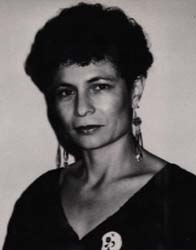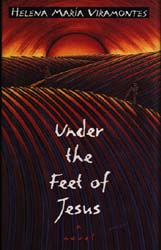|

BIOGRAPHY
Helena Maria Viramontes (b. 1954) was born in East Los Angeles, the
daughter of a construction worker and a Chicana housewife who raised six
daughters and three sons in a community that offered refuge for relatives
and friends crossing the border from Mexico into California. After
graduation from Garfield High School, Viramontes worked twenty hours a
week while earning her B.A. from Immaculate Heart College, one of five
Chicanas in her class. She then entered the graduate program at the
University of California at Irvine as a creative writing student, but she
left in 1981 and completed the requirements for the M.F.A. degree after
the publication of her stories.
Viramontes began to place her stories in small magazines such as
Maize and XhismArte Magazine as well as the anthology
Cuentos: Stories by Latinas (1983). Her first book, The Moths and
Other Stories was published in 1985 by Arte Publico Press in Houston,
Texas. The same year the University of California at Irvine sponsored the
first national conference on Mexican American women writers, resulting in
the volume Beyond Stereotypes: A Critical Analysis of Chicana
Literature (1985). Three years later Viramontes helped organize a
second Chicana writers conference at Irvine and coedited the anthology
Chicana Creativity and Criticism (1988).
In 1989 Viramontes received a National Endowment for the Arts
Fellowship grant. In 1993 she published her second book of short stories,
Paris Rats in E.L.A. Her first novel, Under the Feet of Jesus,
followed in 1995.

BIOGRAPHY -
CRITICISM
Helena Maria Viramontes was born in East Los Angeles, California,
on February 26, 1954. She attended Immaculate Heart College, majoring
in English Literature, and recieved her B.A. in 1975. It was in
college that she began writing, first poetry and then fiction. Her
stories were soon published and recognized. In 1977, she won first
prize in a literary contest sponsored by Statement magazine for
her story "Requiem for the Poor." She also won the Statement
prize the following year for her story "The Broken Web," and in 1979
was awarded the fiction prize in the University of California at
Irvine Chicano Literary Contest for the short stoty "Birthday."
In 1981, Viramontes enrolled in a Masters of Fine Arts Creative
Writing Program at UC-Irvine, which she recently completed. In 1983,
two of her stories were published in the anthology Cuentos: Stories
by Latinas, and another story appeared in Women of Her World,
an anthology published in 1985. She also received a National Endowment
for the Arts Fellowship to attend a workshop given by Gabriel Garcia
Marquez at the Sundance Institute. Viramontes has collaborated with
Maria Herrera Sobel on two anthologies, Chicana Creativity and
Criticism: Creative Frontiers in American Literature (1988), and
Chicana Writers: On Word and Film (1993). Also in 1993,
Viramontes wrote Paris Rats in E.L.A., a screenplay that has
been produced by the American Film Institute.
Helena Maria Viramontes has received critical acclaim for her short
stories for their masterful depictions of Chicano culture. She mainly
writes about people she has known since childhood, especially family
and friends. With regard to her parents' influence on her writing, the
author states: "If my mother showed all that is good in being female,
my father showed all that is bad in being male." Viramontes focuses on
the struggles and sufferings of Chicana women with their households,
their culture, and their society.
The short story "Growing," which is included in her work The
Moths and Other Stories (1985), illustrates how a young women's
coming-of-age separates her from the rest of the family. In one scene,
when Naomi asks her father why he suddenly becomes distanced from her,
he says, "tu eres mujer," you are a woman. Viramontes ultimately
wishes to portray how women, in particular Chicana women, are
discriminated against merely because of their sex.
 Another powerful
novel is titled Under the Feet of Jesus, which is about a young
California migrant worker's dream of becoming a geologist. Estrella is
thirteen when she arrives in her new temporary home with her younger
siblings, her mother Petra, and the man who is not her father,
Perfecto. Estrella's ebullient spirit is painfully contrasted with
Petra's coping, mid-thirties fatigue. Another powerful
novel is titled Under the Feet of Jesus, which is about a young
California migrant worker's dream of becoming a geologist. Estrella is
thirteen when she arrives in her new temporary home with her younger
siblings, her mother Petra, and the man who is not her father,
Perfecto. Estrella's ebullient spirit is painfully contrasted with
Petra's coping, mid-thirties fatigue.
This California is not the legendary destination of blissful
contemplation, but rather the landscape one drives over and hikes
across to get to the next job. When Viramontes describes Estrella's
family trying to cross a highway, the immediacy of the narrative
moment is striking, and the images of their hard labor are
extraordinary. Viramontes has dedicated this novel to her parents, who
met while picking cotton, and to the memory of Cesar Chavez, leader of
the United Farm Workers.
Viramontes' stories , in essence, communicate the overwhelming
trials and tribulations that Chicana mothers, wives, and daughters
face. They utilize stream-of-consciousness narrative, magic as
literary symbols, and multiple narrators to depict the thoughts and
emotions of these beautiful and haunted women. Still other issues
portrayed in her works include politics, religion, and sexuality. Her
influences include Gabriel Garcia Marquez, Ana Castillo, Sandra
Cisneros, Alice Walker, Ntozake Shange, and Toni Morrison.
The author is currently an Assistant Professor of English at
Cornell University. In addition, her latest novel, Their Dogs Came
with Them, published in 1996, is about the brutality of the
Spanish conquest of the Americans. Not only is Viramontes expanding
her writing, but she is involved with the MTU Writing Center Latino
Read-In, where she is a consultant. She has also counseled Chicano
students at Cornell's Summer College.
SELECTED
BIBLIOGRAPHY
Works by the Author
 | Their Dogs Came with Them (forthcoming) |
 | Under the Feet of Jesus (1995) |
 | Paris Rats in E.L.A. (1993) |
 | The Moths and Other Stories (1985) |
Co-authored with Maria
Herra Sobek:
 | Chicana Writers: On Word and Film (1993) |
 | Chicana Creativity and Criticism: Creative Frontiers in
American Literature (1988) |
Works about the Author
 | Davidson, Cathy N. and Linda Wagner-Martin, eds. The Oxford
Companion to Women's Writing in the United States. New York:
Oxford University Press, 1995. |
 | Fernandez, Roberta. "The Cariboo Cafe: Helena Maria Viramontes
discourses with her social and cultural contexts." Women's Studies
17.2 (1989): 71-85. |
 | Fox, L.C. "Chicana Creativity and Criticism: Charting New
Frontiers in America." College Literature 18.1, (1991):
103-106. |
 | Hassett, J.J. "Under the Feet of Jesus-Viramontes, HM."
Chasqui-Revista de Literatura Latinoamericana 25.2 (1996). |
 | Magill, Frank N., ed. Masterpieces of Latino Literature.
New York: Salem Press, Inc., 1994. |
 | Pavletich, J.A. and M.G. Backus. "With His Pistol in Her Hand:
Rearticulating the Corrido Narrative." Cultural Critique 27
(1994): 127-152. |
 | Peck, David and Eric Howards, eds. Identities and Issues in
Literature. Pasadena, CA: Salem Press, Inc., 1997. |
RELATED LINKS
-
Reflections on The Cariboo CafÈ and Miss Clairol
- Student Emilia Vasquez offers her thoughts on the writings of
Helena Maria Viramontes. Also included are some helpful links to other
sites about Viramontes.
-
"The Moths"
- Information about Viramontes' story "The Moths."
-
Helena Maria Viramontes
- Information about Viramontes' life and words from Beford-St.
Martin's Press.
- "The
Jumping Bean"
(From Voices from the Gap)

Helena María Viramontes (b. 1954)
Contributing Editor: Juan Bruce-Novoa
Classroom Issues and Strategies
The story touches on so many social issues that class discussion is
almost assured. Some students, however, may express a sense of overkill:
too many social and political ills too rapidly referenced to produce a
profound impression. The class may also divide over the issues, some
finding that they are so often covered by the media that they hardly
need repetition, while others like the story because it seems like a
familiar exposé on subjects they consider everyday reality.
You may find yourself in a discussion more of the headnote and its
advocacy of the rights of undocumented aliens than of the story itself.
I would try to focus on close textual reading to prevent the discussion
from drifting away from the text and into arguments over social and
political policies. Yet, some explanation of U.S. immigration policies
and the political issues in Central America may be necessary (see "Historical
Perspectives").
Major Themes, Historical Perspectives, and Personal Issues
Viramontes has published few stories and the headnote provides ample
information on her themes and the personal connection with them.
Historically, however, students may need more help. The Latino
characters are undocumented aliens, and as such they can be detained by
Immigration and Naturalization agents. After a hearing, they can be
repatriated to their country of origin. However, in the recent past the
process for Central Americans has more often than not tended to allow
delay of their return, especially for those who claim political asylum.
For Mexican aliens, the process is usually more automatic, although
their return to the U.S. is also quite usual. The headnote suggests that
the female refugee comes from El Salvador, which may provoke some
confusion, since in the story her son is accused of collaborating with "Contras,"
a right wing terrorist group supported by the U.S. in the 1980s to
undermine the Sandinista regime in Nicaragua. This could lead to
ambiguous interpretations (just who has killed the woman's son, the
Nicaraguan left or the Salvadorean right?) that can be used to lend the
story interesting ambiguity to undermine simplistic political positions
of right and wrong.
Significant Form, Style, or Artistic Conventions
Narrative perspective varies, moving from one character to another.
While the technique may disorient some students, most will have
encountered it in previous studies. It is important for them to note how
Viramontes changes diction levels to achieve characterization. The use
of interior monologue, especially in Section II, is noteworthy but not
difficult to comprehend. The dashes of the "Rashamon" technique--the
viewing of the same event from different perspectives at different
times--adds to the text's fragmented feel.
Original Audience
Viramontes addresses a contemporary U.S. audience with topics
relatively well known to most readers.
Comparisons, Contrasts, Connections
Comparisons can be made with
Rolando Hinojosa's selection, which also utilizes the fragmented
narrative while the subtlety of Hinojosa's social commentary can be
contrasted with Viramontes's blatant approach. One might also place
Viramontes in the tradition of such writers as
Harriet Beecher Stowe,
Watkins Harper, or
Upton Sinclair, writers who did not shy away from explicit advocacy
of political positions, even at the risk of melodramatic excess. While
the headnote refers to García Márquez and Isabel Allende, there is
little of the Latin American Magical Realism associated with those
authors; the connection would be to their political positions, not to
their style.
Questions for Reading and Discussion/Approaches to Writing
1. The basic assignment here is to establish how the story is being
narrated: From whose perspective is something seen? Then I ask students
to characterize the different perspectives by picking specific words,
turns of phrases, motifs, and so on.
2. I ask students to identify the specific Latino content of the
story. Then I ask them to consider if the experiences apply to other
immigrant groups, or the human condition in general.
3. This story lends itself to creative writing assignments. Have
students pick a recent news event and narrate it from the objective
perspective of a reporter and then from at least two others; for example,
a witness of and a participant in the event.
(From the Health anthology)

|
|
![]()